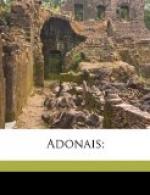The Masque of Anarchy and Peter Bell the Third, both written by Shelley in 1819, were published later on; also various minor poems, complete or fragmentary. Peter Bell the Third has a certain fortuitous connexion with Keats. It was written in consequence of Shelley’s having read in The Examiner a notice of Peter Bell, a Lyrical Ballad (the production of John Hamilton Reynolds): and this notice, as has very recently been proved, was the handiwork of Keats. Shelley cannot have been aware of that fact. His prose Essays and Letters, including The Defence of Poetry, appeared in 1840. The only known work of Shelley, extant but yet unpublished, is the Philosophical View of Reform: an abstract of it, with several extracts, was printed in the Fortnightly Review in 1886.
MEMOIR OF KEATS.
The parents of John Keats were Thomas Keats, and Frances, daughter of Mr. Jennings, who kept a large livery-stable, the Swan and Hoop, in the Pavement, Moorfields, London. Thomas Keats was the principal stableman or assistant in the same business. John, a seven months’ child, was born at the Swan and Hoop on 31 October, 1795. Three other children grew up—George, Thomas, and Fanny, John is said to have been violent and ungovernable in early childhood. He was sent to a very well-reputed school, that of the Rev. John Clarke, at Enfield: the son Charles Cowden Clarke, whom I have previously mentioned, was an undermaster, and paid particular attention to Keats. The latter did not show any remarkable talent at school, but learned easily, and was ‘a very orderly scholar,’ acquiring a fair amount of Latin but no Greek. He was active, pugnacious, and popular among his school-fellows. The father died of a fall from his horse in April, 1804: the mother, after re-marrying, succumbed to consumption in February, 1810. Before the close of the same year John left school, and he was then apprenticed, to a surgeon at Edmonton. In July, 1815, he passed with credit the examination at Apothecaries’ Hall.
In 1812 Keats read for the first time Spenser’s Faery Queen, and was fascinated with it to a singular degree. This and other poetic reading made him flag in his surgical profession, and finally he dropped it, and for the remainder of his life had no definite occupation save that of writing verse. From his grandparents he inherited a certain moderate sum of money—not more than sufficient to give him a tolerable start in life. He made acquaintance with Leigh Hunt, then editor of the Examiner, John Hunt, the publisher, Charles Wentworth Dilke who became editor of the Athenaeum, the painter Haydon, and others. His first volume of Poems (memorable for little else than the sonnet On Reading Chapman’s Homer) was published in 1817. It was followed by Endymion in April, 1818.




